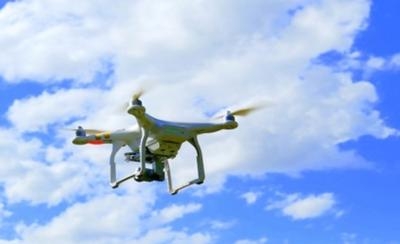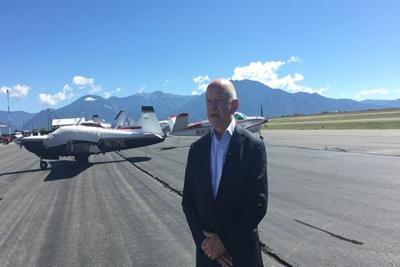Recommends U.S. And Canadian Lawmakers Appropriate Targeted Funds To Federal Aviation Agencies, And Extend Interdiction Authority To Trained State And Local Law Enforcement Agencies
The Blue Ribbon Task Force on UAS Mitigation at Airports released its report on unmanned aircraft systems (UAS) integration, detection, identification, and mitigation in and around airports. The Task Force, jointly commissioned in April 2019 by Airports Council International-North America (ACI-NA) and the Association for Unmanned Vehicle Systems International (AUVSI), recommends the U.S. Congress appropriate more funds to the FAA, the Canadian Cabinet appropriate more targeted funds to Transport Canada, and both legislative bodies extend UAS interdiction authority to trained state and local law enforcement agencies.

“Whether the origin of drone activity near airports is careless, clueless or criminal, the escalating frequency of drone-related incidents present a security, operational and economic challenge to North American airports and their surrounding communities,” said Deborah Flint, Chief Executive Officer, Los Angeles World Airports (LAWA). “The findings of the Blue Ribbon Task Force provide North American airports with a template for developing a response to drone incidents while providing a voice and representation for airports to the federal entities that control drone regulation. The time has come to take meaningful action on this issue to protect the nation’s traveling public.”
The final report builds on the policy recommendations the Task Force outlined in its July 2019 interim report, which urged federal aviation agencies to move forward with a remote identification rule. These recommendations, if implemented, would help UAS safety and security move forward in a timely and risk-based fashion, allowing the UAS industry to continue to grow with compliant operations and ensuring airports remain safeguarded from careless, clueless, or criminal operators. In the final report, the Task Force recommends:
- Lawmakers should do more to ensure the FAA and Transport Canada are adequately funded to undertake UAS detection in conjunction with airport operators. The final report identifies an unacceptable security gap at many airports across the U.S. and Canada, with no federal role in UAS detection and often no resources for an airport role to engage in UAS detection operations. The Task Force takes the position that airports should not be burdened with undertaking UAS detection operations but instead, as with many other operations at airports, such as airport security, UAS detection should be a shared responsibility between airports and federal governments.
- Lawmakers should extend authority to engage in UAS interdiction—kinetic or electronic—to trained law enforcement officials tasked with safeguarding airports and the immediate surrounding areas. The deputation of counter-UAS authority to these officials should begin with a pilot program overseen by the Department of Justice (DOJ) in consultation with the Department of Homeland Security (DHS), in the U.S., and DOJ and Public Safety in Canada (PSC), to establish protocols, training, and practice exercises.

“I am very excited about the new opportunities that commercial UAS applications create for our economy and the value the technology adds to airports; however, the integration of approved operations and detection and mitigation of unapproved UAS must be attentively managed and properly funded and staffed at all levels,” said Task Force Co-Chair Michael Huerta (pictured), who served as Administrator of the FAA from 2011-2018.
The report also contains feedback on the U.S. Transportation Security Administration’s (TSA) draft Tactical Response Plan (TRP) for UAS incursions at airports. With the U.S. Congress set to receive recommendations on these key items from the Executive Branch, the Task Force hopes its recommendations will serve as a valuable resource for Congress and the federal agencies studying this issue.
ACI-NA President and CEO, Kevin Burke, lauded the Task Force’s airport playbook. “When an unauthorized UAS is spotted on an approach pathway or over a runway, what is an airport to do? The playbook put forward by the Task Force represents a necessary component to determining the threat level, the appropriate responses, and ensuring there is proper communication with all relevant stakeholders in a timely fashion. This will be an essential tool for airports to develop or refine their response protocols,” he said.
After discussions with dozens of airport operators in the U.S. and Canada, the Task Force noted that most do not have a comprehensive plan to deal with errant UAS—whether careless, clueless, or criminal. Further, most airports do not have a plan for integrating compliant UAS operations either. The Task Force developed guiding principles for airports seeking to write these critically important plans and recommends ways to drill them just as airports would other emergency procedures.
AUVSI president and CEO Brian Wynne commended the Task Force for its work seeking to ensure safety and security objectives are met through collaboration between industry and government. “The Blue Ribbon Task Force has provided us with clear steps forward to keep the skies around airports secure while still allowing the burgeoning UAS industry to flourish,” Wynne said. “We look forward to working with policymakers to swiftly implement the Task Force’s recommendations and help ensure the safety of the airspace for all aircraft – both manned and unmanned.”
(Source: Task Force news release. Image from file)
 ANN's Daily Aero-Term (05.17.24): Very High Frequency
ANN's Daily Aero-Term (05.17.24): Very High Frequency ANN's Daily Aero-Linx (05.17.24)
ANN's Daily Aero-Linx (05.17.24) ANN FAQ: Submit a News Story!
ANN FAQ: Submit a News Story! Classic Aero-TV: ANN Visits Wings Over The Rockies Exploration Of Flight
Classic Aero-TV: ANN Visits Wings Over The Rockies Exploration Of Flight Airborne Affordable Flyers 05.16.24: PRA Runway, Wag-Aero Sold, Young Eagles
Airborne Affordable Flyers 05.16.24: PRA Runway, Wag-Aero Sold, Young Eagles




